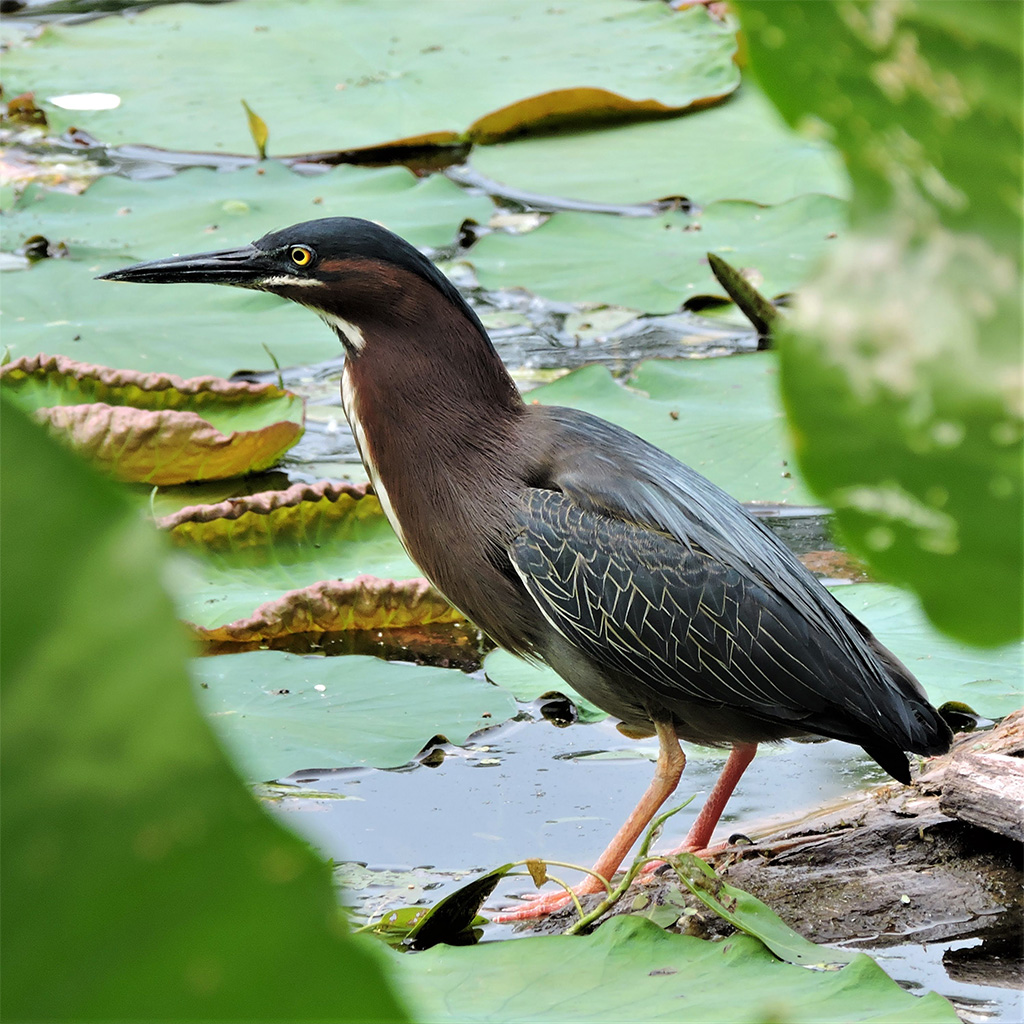Green herons can be unusual in the bird world, fishing with bait and boating around on lilypads

A green heron perches in Cambridge at Strawberry Hill on Aug. 6, 2021. (Photo: Richard George)
There are nine species of herons in Massachusetts, including the well-known great blue and the all-white egret, but right now in Cambridge you are likely to see the lesser-known green heron (Butorides virescens).
You’ll recognize it as a small, stocky bird that weighs about 8 ounces and is a bit smaller than a crow. It has a striking chestnut-colored neck, greenish-blue wings and a dark crown. The bill is dark with a sharp point; the legs are orange. Females are a bit duller in color than the males. Some people might confuse herons with similar birds such as storks or cranes, but herons are different in that they fly with their necks retracted rather than outstretched.

A green heron spears a meal in the Cambridge Highland on July 12. (Photo: A.J. Kleber)
Green herons migrate north in March or April, earlier than most other herons, and begin arriving in Massachusetts in April. They stay throughout the summer, then head back south in September.
John James Audubon described their migration:
I have observed their return in early spring, when arriving in flocks of from 20 to 50 individuals. They plunge downwards from their elevated line of march, cutting various zigzags, until they all simultaneously alight on the tops of the trees or bushes of some swampy place. These halts took place about an hour after sunrise. [At sunset], they would at once ascend in the air, arrange their lines and commence their flight, which I have no doubt continued all night.

When excited, green herons raise their crown feathers into a mohawklike crest. (Photo: Richard George)
After arriving in the spring, a male heron chooses a nest site, often in the fork of a tree close to or over water, where hunting for food is easier. The male gathers nest-building supplies, such as twigs and leaves, but the female is the architect who designs and weaves the nest. The shallow nest platforms are usually about 12 inches in diameter.
The female lays about four eggs, which she incubates for three weeks. After the chicks hatch, the parents regurgitate food for the babies in the morning and evening. After three weeks, the youngsters fly from the nest, but the parents continue to feed them (less and less) for another month.

A green heron alights at Yates Pond in Cambridge. (Photo: Ann Schlesinger)
Many birds have a layer of fine feathers under their exterior feathers. This fluff is called down. Baby birds have only down feathers. Some non-avian dinosaurs probably also had them. Green herons have a special type called powder down that grows in dense patches mostly on the underside of the body, and do not molt them, because they grow continuously. The tips disintegrate, forming a dust made of keratin; the heron uses a fringed toe to collect the dust and work it into its other feathers. Scientists believe powder down, which is oily and sticks to feathers, helps waterproof the bird. It may also help with feather maintenance by absorbing dirt or grit, making it easier for the heron to clean itself when it preens.

A green heron surveys the scene at Blair Pond in Cambridge. (Photo: Ann Schlesinger)
Green herons hunt by walking slowly though shallow water looking for fish, often using their feet to stir up animals in the water or sediment. While standing at the water’s edge, they may also use tools, unusual in the bird world. A green heron will drop bread, flies or feathers on the surface of water to lure small fish. When the fish attack the bait, the heron lunges forward, grabbing or impaling the fish.

A green heron floats on a lilypad boat while it eats. (Photo: Richard George)
If you frighten a heron enough to make it fly away, it will squawk and release a stream of white excrement. This has led to green heron nicknames such as shitepoke and chalk-line. Green herons were well known to hunters and fishers around the turn of the century. In fact, sometimes they were even kept as pets, as evidenced by this 1901 Cambridge Tribune article: “One of our household pets, a green heron, confined by a long cord to a tree in the yard, spent much time by day standing upon one leg, his shoulders hunched up, as though asleep.” (Thankfully, people today do not capture wild birds, but the practice was common 100 years ago.)

A green heron at Black’s Nook by Cambridge’s Fresh Pond uses its acute vision to scan for danger. (Photo: Ann Schlesinger)
Green herons are territorial and will defend their nests aggressively from animals such as snakes, crows and grackles that will eat their eggs and raccoons, which will eat the chicks. Raptors will eat the adults. It’s dangerous being a little green heron. Despite the dangers, for many years green heron populations remained stable. Today, there is some evidence their numbers are declining. If you spot a green heron, enjoy its beauty and its hunting skill, but try not to disturb it.

Green herons can swallow surprisingly large fish, as seen at Fresh Pond in Cambridge on June 15. (Photo: Laura Kiesel)
![]()
Have you taken photos of our urban wild things? Send your images to Cambridge Day, and we may use them as part of a future feature. Include the photographer’s name and the general location where the photo was taken.
Jeanine Farley is an educational writer who has lived in the Boston area for more than 30 years. She enjoys taking photos of our urban wild things.



